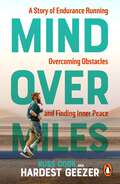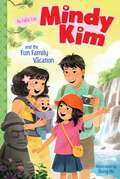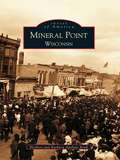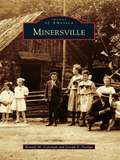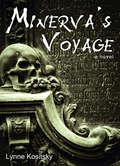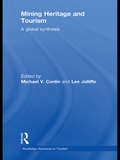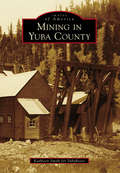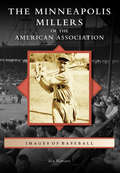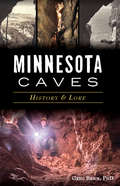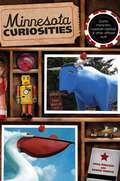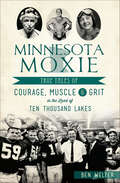- Table View
- List View
Mind over Miles: Mind over Miles - The untold story behind the record-breaking run
by Russ Cook10,000 miles. 16 countries. 352 days.Hardest Geezer, Russ Cook, is the first person to run the entire length of Africa. From his starting point in Cape Agulhas, South Africa, through sandstorms in the Sahara Desert, rainforests, mountain ranges and long empty roads stretched out for miles in front of him, Russ ran the equivalent of 386 marathons finally crossing the finish line in Tunisia 50 weeks later.Attempted kidnaps, being held at gunpoint in an armed robbery and the whole challenge left hanging in the balance when he was denied the right to cross Algeria, Russ never once contemplated giving up. When he crossed the finish line in Ras Angela, he did so with the eyes of the world on him.Africa may have been his most physical challenge yet but it certainly wasn’t his first: he’s broken the record for the fastest car-pulling marathon and been buried alive for a week with nothing but water and a camera to record the experience.In Hardest Geezer: Running Africa, Russ Cook shares how he turned his life around to face these challenges and shares his motivations and tales of incredible determination, sheer grit and endurance.‘You get one chance at life. Go and have a stab at it.’
Minden Perserverance and Pride: Perseverance Of Pride (Making of America)
by John A. AganThe beautiful historic town of Minden is tucked up in the pine-filled hills of northern Louisiana. Established by Charles Hanse Veeder in 1835, a third-generation German-American originally from upstate New York, Minden rapidly earned a reputation as a town of unique character, aided by the Minden Academy and the early introduction of the Methodist, Baptist, and Episcopalian religions. After Veeder left the town, the hearty settlers remained to foster Minden's growth and development. Although the seat of Webster Parish today, Minden has faced expansion fluctuations, caused by natural disaster and economic hardship, but followed by ambitious industrial endeavors and renewed hope.Minden thrived commercially, with economic gain centralized in Bayou Dorcheat, which was composed of separate landings acting as shipping points for goods coming from much of northern Louisiana. Industries like cotton farming and the Minden Lumber Mill, formed in 1901 as one of the largest mills in the United States at the time, caused the town's population to nearly double in just ten years. Under the leadership of great men like E.S. Richardson, Minden also became a model for other towns of similar size in the field of education. At the same time, disastrous fires, a catastrophic tornado, and the devastation of the steamboat trade on Bayou Dorcheat by the coming of the railroad challenged the community in the ever-changing twentieth century.
Mindful Eye, Playful Eye: 101 Amazing Museum Activities for Discovery, Connection, and Insight
by Frank Feltens Michael Garbutt Nico RoenpagelExperience art and design as you've never experienced them before with 101 imaginative, mindfulness-based practices that will engage your senses, open your mind, and transform your next museum visitSwitch off your phone, take a deep breath, and prepare for adventure. Mindful Eye, Playful Eye invites readers on a thoughtful journey through museums, with 101 practices designed to nurture the development of attention, creativity, and compassion. This book encourages a playful and reflective approach to the museum experience of viewing art, sculptures, fossils, jewelry, aircraft, and more, including suggestions to:Imagine an object features prominently in a film or novel. What role does it play in a love story, thriller, and sci-fi?Pose to mirror a piece and consider the sensations that arise.Encounter as many objects as you can while holding your breath.Switch between scientific and empathic modes of viewing an object.Activities include instructions for both individual and partnered exploration. Whether frequenting a favorite museum or exploring an unfamiliar one, this book will enrich solo trips and add a unique element of connection to romantic or friend dates. Practices are divided into 5 categories:Body: explores how your body responds to museum objects.Vision: challenges established visual habits and encourages experimentation.Mind: focuses on thoughts and feelings that animate your inner world.Imagination: encourages you to imagine new ways of being.Action: transforms you into an art maker and performance artist.The practices can be performed in any museum in the world. Mindful Eye, Playful Eye empowers museumgoers to encounter museum collections, themselves, and each other with heightened awareness, centeredness, and a sense of unabashed joy.
Mindful London: How to Find Calm and Contentment in the Chaos of the City
by Tessa WattMindful London invites you to slow down, wake up and be present to the everyday in a more meaningful way, in one of the world’s greatest cities. For Londoners and visitors looking to enhance their experience of the city, and for those curious about mindfulness, this is your essential guide. Features quiet and peaceful places to retreat to in the middle of the chaos, from the silence and sanctuary of libraries, museums and churches to the rejuvenating influence of nature found in London’s myriad green spaces and waterways. Includes suggestions for things to do that will help you de-stress and re-energise, from yoga and tai chi to wild swimming and other more restorative forms of exercise, to mindful ways to appreciate London’s architecture, art and music, as well as the city’s more informal sights and sounds. However, mindfulness is really all about being more present, awake and aware in all elements of our daily lives. At the core of this book you will find simple mindfulness exercises, reflections and reminders that are easy to incorporate into your busy day: on the Tube, bus or walking to work, while eating a quick lunch, working out at the gym, waiting in a queue or at the red light. Mindful London is the secret to living a more balanced life in the big city. Features: – The best green spaces, waterways and wildlife, and the importance of nature to mindful city living – How to take a fresh look at art and notice the city’s everyday architectural details – Exercises for mindful commuting, whether you are on the bus, the train or walking to work – Peaceful interiors, hideaways and sanctuaries – Mindful listening, from music to the sounds of the city – Yoga, tai chi, mindful running, wild swimming and other forms of mindful movement – Practical mindfulness techniques to try throughout and a guide to mindfulness and meditation centres, groups, events and courses
Minds & Hearts: The Story of James Otis Jr. and Mercy Otis Warren
by Jeffrey H. HackerAs a firebrand attorney and political agitator, James Otis Jr. helped to shape colonial resistance in the decades leading up to the American Revolution, establishing individual rights and "no taxation without representation" as cornerstones of the patriot cause. After his violent coffeehouse altercation and bouts with mental illness, his younger sister, Mercy Otis Warren, took up his cause. Her incendiary plays and poems rallied colonial opinion in the lead-up to the war, and her chronicle of the period established her as America's first female historian.Minds and Hearts is the dual biography of these remarkable siblings, placing James and Mercy in the spotlight together for the first time, amid the rush of events, competing ideologies, and changing social conditions of eighteenth-century America. Jeffrey H. Hacker crafts a compelling narrative that focuses on the Otises' unique and dramatic relationship and traces their impact on the Revolutionary movement in Massachusetts. If the real American Revolution took place "in the minds and hearts of the people," as John Adams claimed, then the Otises were among the nation's true patriots.
Mindy Kim and the Fun Family Vacation (Mindy Kim #12)
by Lyla LeeFresh Off the Boat meets Junie B. Jones in this adorable chapter book series following Mindy Kim, a young Asian American girl—in this twelfth and final novel, Mindy and her family vacation to South Korea.Mindy is so excited to go back to Korea—not only are she, Dad, and Julie going to the popular tourist spot, Jeju Island, it&’s baby Charlie&’s first big international trip! Mindy can&’t wait for some lazy days on the beach and to see the natural sites unique to the island. But the trip gets off to a rocky start, and Mindy finds herself hoping this first vacation together won&’t be memorable for all the wrong reasons!
Mineral Point, Wisconsin
by Herbert Beall Barbara Apelian BeallMineral Point, Wisconsin, recounts the changing fortunes of a once rough-and-ready mining town of the 1820s. Featuring historic photographs from the collection of the Mineral Point Historical Society and Pendarvis-Wisconsin State Historic Site-an exciting history unfolds in these pages, with the arrival of miners from the fledgling United States in the 1820s in search of lead. When the demand for lead collapsed, Mineral Point shifted its focus to the mining of zinc, only to have that market drop after World War I. Mineral Point was reawakened in the 1930s with the influx of artists and others, like Edgar Hellum and Robert Neal, who were interested in historic preservation. The town has transformed itself once again, becoming a vibrant artistic, historic, and architectural center. In 1971, it became the first Wisconsin community to be placed on the National Register of Historic Places, with 514 contributing buildings. This fascinating pictorial history celebrates the people of Mineral Point-the early American settlers from Missouri, Illinois, and Kentucky, and the Cornish, German, Irish, and Italian immigrants. Mineral Point, Wisconsin, also features their legacy-their homes, businesses, schools, and organizations. These historic photos provide glimpses of the extensive zinc works that no longer exist, as well as many of the buildings still standing in the town today.
Mineral Wells
by Sue SeibertThe family of James Alvis Lynch headed west from Denison, Texas, to find a dry climate that would alleviate Lynch's symptoms of malaria and his wife Amanda's rheumatism. They traveled as far as the Brazos River, where U.S. 180 crosses today, when one of their oxen drowned, and the other was struck by lightning. To make matters worse, the Lynches learned of hair-raising tales of the struggles between Comanches and settlers. So on Christmas Eve in 1877, the Lynch family decided to settle 4 miles east of the Brazos in the beautiful valley between what are the East and West Mountains in present-day Mineral Wells. There, the Lynch family discovered the mineral-rich water that mended their maladies and brought tourists from far and wide to take the healing cure. The geology of the area also brought oil, gas, and brick plants, while the attacks on local settlers brought a military presence to the region. The history of Mineral Wells is alive today, as many descendants of early pioneers still live and work in the community, full of pride for their families' contributions to the area.
Minersville (Images of America)
by Joseph E. Szeliga Ronald M. ColemanMinersville, aptly named for those who toiled in the coal fields of east-central Pennsylvania, embodies the very essence of the coal region. This town and surrounding areas, however, are much more than abandoned breakers and row after row of coal company houses. Although coal is no longer king, the people of Minersville still take pride in their heritage. The gridiron battles of the Pottsville Maroons, the much-disputed 1925 NFL champions, and the failed political campaign of Lewis Cass against Zachary Taylor and Millard Fillmore proved that more than coal could come from this region. Minersville provides a glimpse of the early days of coal, as well as the people of the area and their accomplishments of spirit.
Minerva's Voyage
by Lynne KositskyCommended for the 2011 Best Books for Kids and Teens Robin Starveling, aka Noah Vaile, is scooped off the streets of seventeenth-century Bristol, England, and dragged onboard a ship bound for Virginia by the murderous William Thatcher, who needs a servant with no past and no future to aid him in a nefarious plot to steal gold. Starveling fits the bill perfectly since he lives nowhere and has no parents. Aboard the ship, Starveling makes friends with a young cabin boy, Peter Fence. Together the two boys suffer through a frightening hurricane and are shipwrecked on the mysterious Isle of Devils. They solve the ciphers embedded in emblems found in Thatchers sea chest, which has washed up with the wreck, then make their way through gloomy forests and tortuous labyrinths to a cave on the shore that houses a wizard-like old man. Beset by danger and villainy on every side, they finally discover the old mans identity and unearth a treasure that is much rarer and finer than gold.
Mines of Clear Creek County
by Ben M. DuganIn 1859, "Pikes Peak or bust!" spread across America and brought men and their families from all over to the Kansas goldfields seeking a new beginning. Thousands came to Clear Creek and Gilpin Counties and eventually settled all of Colorado. The mining communities of Idaho Springs, Georgetown, Empire, Silver Plume, Dumont, and Lawson all exist because of the pursuit of gold and silver. Gold was initially easy to get to, but in time, underground mineral development was necessary. New technologies and the Industrial Revolution made mining easier, but there was still work to be done to establish local fire departments, churches, schools, and governments.
Mingo Junction
by Larry Smith Guy MasonMingo Junction, a working-class town in the upper Ohio River Valley, has a rich mix of ethnicities and races with a history going back to the Mingo Indians, including visits from George Washington in the 1770s. Early settlement came as the coal mining industry flourished, followed by iron and steel foundries and accompanying railroads and river barge traffic. Mingo's chief industry is its steel mill, first Carnegie Steel Mill, then Wheeling-Pitt Steel Mill for over 100 years. The town's deep character is etched in its work, social, cultural, and natural landscapes. This is seen in its schools, churches, businesses and industry, daily life, active social organizations, and its famous figures: Jake Strott and George Kakasic of the 1930s Pittsburgh Steelers (Pirates); Joe Fortunato of the Chicago Bears; coach Woody Hayes; Spud Hughes, inventor of menthol cigarettes; and Bill (Lil Squirt) Albaugh, spokesperson for Squirt soda. Renowned singing groups include The Antones, The Stereos, Buddy Sharp and the Shakers, The Mingo Men, and Bob Parissi of Wild Cherry. Among major movies filmed in the town are Reckless, Hearts of Steel, and 1978 Academy Award winner The Deer Hunter.
Mini Mickey: The Pocket-Sized Unofficial Guide to Walt Disney World
by Bob Sehlinger Ritchey HalphenMini-Mickey: The Pocket-Sized Unofficial Guide to Walt Disney World is the condensed version of the Unofficial team's comprehensive Unofficial Guide to Walt Disney World. <P><P>Though its format is slightly larger than true pocket-sized, this is an indispensable take-along guidebook. Straightforward, tightly organized, and well indexed, Mini-Mickey is the perfect resource when you want the most important information fast.For readers on a short or impromptu trip to Walt Disney World the contents of Mini-Mickey can easily be digested on the flight or drive down, or at the hotel the night before visiting the parks. Scientifically created touring plans for each park will save four or more hours of standing in line.For those who simply do not have time to plan their Disney trip in depth, Mini-Mickey will take the guesswork out of visiting the parks and ensure that the reader will see as much as possible with the least amount of stress and effort. This book provides expert authority on how to make the most efficient and most practical use of any family's time.Because every minute and every dollar counts, Mini Mickey: The Pocket-Sized Unofficial Guide to Walt Disney World provides the information needed to tour Walt Disney World like a pro.
Mini-Mickey: The Pocket-Sized Unofficial Guide to Walt Disney World (Eleventh Edition)
by Bob Sehlinger Len Testa Ritchey HalphenThis is a portable CliffsNotes-style version of The Unofficial Guide to Walt Disney World. It distills information from the larger book to help short-stay or last-minute visitors decide quickly how to plan their limited hours at Disney World.
Mini-guide de Bassano del Grappa: Réservé aux passionnés de voyages
by Tania ZontaLe mini-guide de Bassano del Grappa vous emmènera à la découverte de la ville, de son histoire et du bon vivre. Vous pourrez organiser votre visite personnelle grâce aux indications suivantes qui vous apporteront : - des informations utiles pour profiter à 100 % de votre séjour - un parcours repéré avec de brèves descriptions des musées et monuments pour connaître l’histoire des lieux - les établissements et restaurants situés dans le centre - des informations sur ce que vous pourrez visiter aux alentours - les personnes qui ont rendu la ville célèbre - le rôle joué par Bassano pendant la Première et la Deuxième Guerre mondiale.
Minik: An Arctic Explorer, a Museum, and the Betrayal of the Inuit People
by Kenn Harper Kevin SpaceyA true story from the great age of Arctic exploration of an Inuit boy's struggle for dignity against Robert Peary and the American Museum of Natural History in turn-of-the-century New York City.Sailing aboard a ship called Hope in 1897, celebrated Arctic explorer Robert Peary entered New York Harbor with peculiar "cargo": Six Polar Inuit intended to serve as live "specimens" at the American Museum of Natural History. Four died within a year. One managed to gain passage back to Greenland. Only the sixth, a boy of six or seven with a precociously solemn smile, remained. His name was Minik.Although Harper's unflinching narrative provides a much needed corrective to history's understanding of Peary, who was known among the Polar Inuit as "the great tormenter", it is primarily a story about a boy, Minik Wallace, known to the American public as "The New York Eskimo." Orphaned when his father died of pneumonia, Minik never surrendered the hope of going "home," never stopped fighting for the dignity of his father's memory, and never gave up his belief that people would come to his aid if only he could get them to understand.
Minimal New York City: Graphic, Gritty, and Witty
by Michael ArndtMake your way from the Flatiron to Flatbush as an award-winning designer expertly captures New York City with minimalist art and unexpected wit.Minimal New York City playfully captures the essence of New York with clever pairs of sharp illustrations and cheeky commentary about the city. Historic context for each illustration is revealed in the back of the book, making it an informative experience for anyone who has ever walked through the bright lights of Times Square, paid $13 for an avocado toast, or indulged in Junior's Cheesecake on Flatbush. Minimal New York City is a celebration of what makes New York New York.As a lifelong resident of New York state who has spent nearly twenty-five years living on the Upper West Side of Manhattan, Michael Arndt has poured his wealth of insider knowledge into Minimal New York City, a graphic love letter dedicated to the place he calls home. His references run the gamut from visual similarities between Central Park and Brooklyn's parks to the ways in which Times Square has evolved from the '70s to today. His visual and verbal wit make the graphics of New York approachable for New Yorkers and Big Apple fanatics alike.
Mining Heritage and Tourism: A Global Synthesis (Routledge Advances in Tourism)
by Michael V. ConlinMany former mining areas have now lost their industrial function and are now turning to tourism for regional revitalization and community economic development. The transformation process of these industrial, and in some cases derelict, mining sites and landscapes into an area of interest for tourists is a major challenge both for planners and for tourism managers. It involves complex consideration to both the preservation of the physical site and community mining heritages as well as the health, safety and environmental factors inherent in opening these vast sites to the public. Mining Heritage and Tourism includes contributions from internationally recognized authorities and is the first book to focus on the issues, challenges and potentials in redeveloping mines as cultural heritage attractions which are explored thematically throughout the book. It draws on multidisciplinary research to consider the dichotomy between heritage preservation and tourist development goals for mining heritage sites as well as to explore the practical challenges of developing these sites. These themes are illustrated by case studies from a vast range of geographical locations around the globe to offer operational insights into the planning and management of these sites for both heritage and tourism purposes, as well as innovative site management techniques. There has never before been a more comprehensive book on mining heritage tourism representing the latest developments in strategy, policy and practices. This book serves as an invaluable guide for students, researchers, academics and practitioners in the areas of Tourism and Heritage Management.
Mining Towns of Southern Colorado
by Victoria Miller Staci Comden Sara SzakalyLesser known than the gold and silver mines of Western lore, Southern Colorado's extensive coal mines fueled the engines for Western industrialization in the late 19th and early 20th centuries. Of the numerous companies operating the mines, the Colorado Fuel and Iron Company (CF&I) was king. With a total of 62 mines, the majority of them in Colorado's Las Animas, Huerfano, and Fremont Counties, CF&I ruled the lives of countless miners in company towns scattered throughout Southern Colorado. Working long hours, often in cramped underground caverns, the workers emerged to families living in lonely mountain landscapes completely provisioned with company homes, stores, schools, and churches. Images of America: Mining Towns of Southern Colorado gives an intimate glimpse into the lives of these pioneer mining families.
Mining in Yuba County
by Yubaroots Kathleen SmithMining in Yuba County illustrates the story of how this geologically unique part of California drew multitudes of people from around the world during the early days of the Gold Rush. It depicts the region's evolution from anarchy to civilization. It gives faces to the individuals who were instrumental in creating society in Yuba. It elaborates on incidents in which Yuba influenced the nation, on matters as historically significant as California entering the Union as a free state and affecting the outcome of the Civil War. Mining in Yuba fostered technological advancement precipitated by the depletion of surface gold and the necessity to get to the obscured gold. Conflicts between miners and agriculturists over hydraulic mining were litigated, and landmark legal decisions regarding the regulation of hydraulic mining all but ended the practice and were the beginnings of environmental protectionism and water rights issues in California. Finally, it reveals that despite heavy regulations that exist today, there is still mining in Yuba County.
Minneapolis Millers of the American Association, The (Images of Baseball)
by Rex HamannThe Minneapolis Millers graced the fields of the American Association for six decades, from 1902 to 1960. Known as a high-level training ground for professional ballplayers, the Millers were also famous for their heated rivalry with the neighboring St. Paul Saints. Drawing on the extensive array of photographs from the Hennepin County Library Special Collections and the author's private collection, Images of Baseball: The Minneapolis Millers of the American Association presents the history of these "boys of summer."
Minneapolis Riverfront, The
by Iric NathansonWith the Mississippi River's only true waterfalls at its front door, Minneapolis harnessed the power of the falls to become an international milling center. Changing market conditions, though, forced Minnesota's largest city to give up its preeminent position in the milling world after World War I. As the local milling industry gradually faded away, Minneapolis turned its back on its riverfront origins. By 1950, a once-bustling commercial area along the banks of the Mississippi had become an industrial wasteland. Then, a decade later, the seeds of renewal were planted when some urban pioneers recognized the potential of this long-ignored historic district. By the first decade of the 21st century, the riverfront had reemerged as a vibrant residential, cultural, and recreational center.
Minnesota Caves: History & Lore
by Greg BrickMinnesota’s caves have a deep history. Carver’s Cave is the first to be described in the literature of North America after explorer Jonathan Carver visited it in 1766. The storied Fountain Cave was the birthplace of the city of St. Paul. Just after the American Civil War, Chute’s Cave inspired an elaborate national hoax regarding an ancient civilization. Folklore surrounds Petrified Indian Cave, where a strangely shaped stalagmite was mistaken for a person turned to stone. Geologist and urban explorer Greg Brick, PhD, uses decades of research to uncover the secrets of geological wonders.
Minnesota Curiosities: Quirky Characters, Roadside Oddities & Other Offbeat Stuff (Curiosities Series)
by Russ Ringsak Denise RemickYour round-trip ticket to the wildest, wackiest, most outrageous people, places, and things the North Star State has to offer!Visit an art gallery of underground graffiti; an eight-story-tall Iron Man sculpture; and some beautifully designed, no-real-name-for-them architectural oddities.Meet an artistic, creature-creating welder; a fast-thinking curator of a fishing museum; and a cow-figurine-collecting newspaper editor.Discover the fun of constructing a bookcase-turned coffin for who-knows-when; traveling an uphill road that goes downhill; and drinking wiggly-army-worm wine—it&’ll make your head spin.Whether you&’re a born-and-raised Minnesotan or a recent transplant, authors Russ Ringsak and Denise Remick will have you laughing out loud as they introduce you to the neighbors you never knew you had and take you to places you never knew existed—right in your own backyard!
Minnesota Moxie: True Tales of Courage, Muscle & Grit in the Land of Ten Thousand Lakes
by Ben WelterMinnesotans are a tough lot, capable of pulling a house six miles by muscle alone or giving birth to a sixteen-pound boy. In 1921, young Phoebe Fairgrave set a parachute world record, stepping off the wing of a biplane 15,200 feet above the Twin Cities. In 1962, the last powerhouse Gophers football team brought home the Rose Bowl trophy. A year later, thirteen-year-old Jean Webb of Minneapolis risked arrest and refused to leave a segregated restaurant. In 1979, Gerry Spiess crossed the Atlantic alone in a 10-foot sailboat he built in his White Bear Lake garage. These inspiring stories and dozens more, culled from the Star Tribune newspaper archives, are presented in their original form by author Ben Welter, along with in-depth background, fresh interviews and more than seventy-five historic photos.
